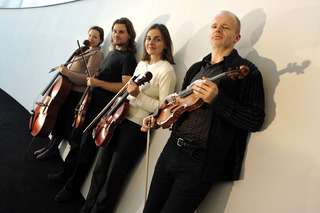|
Back
Two B’s Or (Decidedly) Not Two B’s New York
92nd Street Y
04/21/2009 -
Anton Bruckner: String Quartet in C minor
Heinz Holliger: String Quartet No. 2 (U.S. Premiere)
Elliott Carter: Fragment No. 1 for String Quartet
Ludwig van Beethoven: String Quartet in F Major, Op. 135
Zehetmair Quartet: Thomas Zehetmair, Kuba Jakowicz (Violins), Ruth Killius (Viola), Urusla Smith (Cello)

The Zehetmair Quartet (courtesy of the 92nd Street Y)
The celebration at the 92nd Street Y last night—for that is exactly how to describe the concert—was far more cohesive than the audience might have thought, for the similarities were not immediately apparent, and many listeners divided the concert in half.
The two centre works were by Heinz Holliger and Elliott Carter, both composers sitting on the aisle, happily applauding their own music. The Holliger-Carter friendship has continued for nearly half a century now (though centenarian Carter thinks of 70-year-old Holliger as a stripling), and the Holliger work was dedicated to Mr. Carter—just as some of Carter’s shorter pieces this evening (April 22) are dedicated to Mr. Holliger
Some in the audience weren’t prepared for the theoretically more difficult living composers, so they were much happier with the two B’s—Bruckner and Beethoven—which were the bookends.
But nobody—or nobody even faintly in their right minds—could have had doubts about the Zehetmair Quartet, led by a violinist who has often played solo violin with Mr. Holliger. This is not only a dashing group, they not only play with panache, style and the most intense vigor, but, especially in the Holliger string quartet, they performed 23 minutes of non-stop quasar-sharp polyphony, which I have never heard anywhere.
As for the supposed difficulty of Holliger and Carter, that would certainly have been true of the scores and playing. But all the audience had to do was—in the words of Carter’s mentor, Charles Ives—“Just listen to the damned music.”
Holliger’s Second String Quartet makes the word “thorny” seem like sugar and cream. Not only are the strings tuned scordatura—that is, mis-tuned up a notch though played with the same notes on paper, leading to a strange disconcerting effect—but I can’t recall a single measure where the strings played in anything a zillion miles away from concordance or with the same rhythm. The six uninterrupted movements were easily distinguished, especially through Mr. Hollinger’s program notes. They went from the fiercely energetic, with a kind of controlled chaos, to a beautiful adagio with almost unbearable rests after each phrase, to a moto perpetuo and a final epilogue with the epitaph “put around the times like clouds”.
The sounds were fragmented, the rhythms (if one can consider such a controlling word) were nervous, jerky, the instruments whirled about each other at quantum pace. I didn’t see the score, but would have imagined each measure at times to have the four soloists to come within a 64th-beat of each other at with frenzied beats.
Yet there were moments of extreme beauty. Mr. Holliger, before the concert, had mentioned that he had grown up with Hungarian music, through one of his teachers, and one could hear a kind of Bartókian night music in the adagio. (Though the simple buzzing of the Hungarian turned into a universe of insects through Mr. Holliger.)
This was the American premiere of the work, written for the Quartet itself. I would love to hear it again and again. But not because I would be able to figure it out (though I’m certain Mr. Holliger has a mathematical rationale), but because it was so stunning. They say that energy cannot be seen, only felt. In this case, primal energy was heard.
Mr. Carter’s first Fragment was only four minutes long, and again, the structure evaded me, probably because there wasn’t one. But the series of harmonics, slides on the high notes, and Webernian separation of instruments were intriguing. It was perhaps only a bagatelle—see the paragraph below—but the sounds and colors were fascinating.
And now the cohesive note: mainly the last work, Beethoven’s final string quartet. After the András Schiff performance of Beethoven’s last piano sonatas a few days ago, this string quartet was again one not of torment or resignation, but of transformation. That was the mood. But now we go back. Nothing in the quartet is what it seems. Like the Carter Fragment, Opus 135 has the feeling of a later Beethoven Bagatelle, themes which get started, which progress, yet which suddenly stop their emotions, as if Beethoven was unable to compose in notes what he felt in his mind.
(One thinks of the last measures of the slow third movement, where violinist Thomas Zehetmair played the most beautiful song in the highest range, yet it wasn’t a song at all, but parts of a song, never quite finishing, always discomforting us, always with more potential than reality.)
Like the Holliger work, the moods changed so quickly here that one never quite caught up with the structure. The mood might have been, as the work is always described, “peaceful and lucid”, but such emotions for Beethoven at this stage, were anything but consistent. After this performance, where the Zehetmair Quartet took every minute variation, emphasizing the defragmentation of the whole, one realized how close Beethoven was to overturning the whole musical structure.
Had Beethoven lived a decade more, he certainly would have given us his own dodecaphonic theory, leaving Schoenberg as a Berlin cabaret piano-player.
The only work which didn’t participate in this wondrous language was Bruckner’s student-written Quartet. Last summer I was very impressed with the Quintet, but this piece, while competent and at times even elegant, was like the out-of-place rock in a Japanese garden which only indicates how brilliant the rest of the aural landscape can be.
Harry Rolnick
|